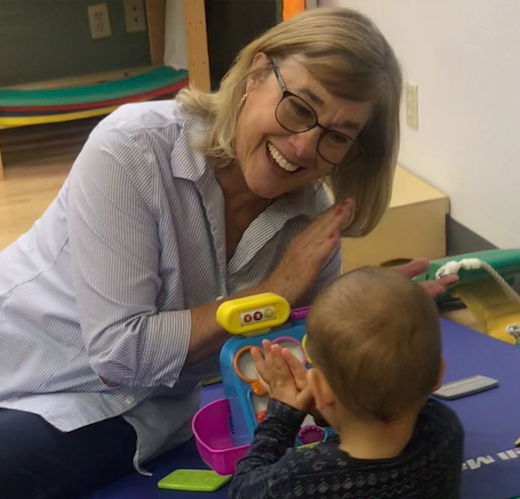Q: What is occupational therapy all about?
A: Most people think occupational therapy is about jobs, recovery, or going back to work. While this is often the case for adults, occupational therapy for kids is completely different. I think this is somewhat misunderstood. The occupation of a child is play, learning how to move and getting along with peers. Pediatric occupational therapy helps a child improve their ability to engage in these tasks so they can grow and develop into healthy adults.
In pediatric occupational therapy, we can use many different modalities or methods, such as movement, art, or sensory equipment, to help a child reach their goals. That’s what I love about it.
Occupational therapy, especially sensory processing, has really grown in the last five years. We’ve found out how plastic the nervous system really is and I think that’s very exciting for us as clinicians. We can make changes in the nervous system, which helps support both physical and emotional health. Occupational therapy can help children with a wide variety of concerns meet their goals.
Q: What will our first session together be like?
A: I have the parents fill out a sensory checklist and some background medical information. I usually start by interviewing the parent and let the child play so they feel comfortable. Then the child and I usually move to the table. I administer fine motor assessments, and standardized testing to look at their visual-motor skills, and handwriting skills. I also look at muscle strength. Then I look at neurological functioning, balance, muscle tone, and proprioception. I give a test of motor proficiency, and by the end of the session I have a good idea of whether the child needs therapy or not. I explain briefly my thoughts and recommendations briefly with the parents and answer any questions the parents may have. After the initial session, I provide a formal occupational therapy evaluation report.
Q: What are ongoing sessions like?
A: I welcome the client in, and ask the parents and the child how their week has been. I always start by asking the child what they think their body needs. Does it need to move? Does it want to do something slow and quiet? Does it want to sit at the table and do a fine motor activity? How we start depends on the child and what they have chosen, but after that I pick activities that I feel are therapeutic for the child.
One of the most important things I do is ensure that the child has fun and enjoys the activities. I also make sure that the activities are just the right challenge, not too easy or too hard. This ensures the child will engage in the process of growth and change. I hope when they leave they’ll feel more organized, better regulated, and fulfilled.
I usually give the parents homework and a little chart to take home. If the child does their exercises 4 times or more per week then they get to pick out a prize the following week.
Q: What are some of your favorite books or resources that you recommend to parents?
A: Sensory Integration and the Child, which was written by A. Jean Ayres, who was a pioneer in the field of sensory integration. Sensational Kids: Hope and Help for Children with Sensory Processing Disorder, by Lucy Jane Miller, and Raising a Sensory Smart Kid, by Lindsey Biel. There are many products in your own home you can use to help your child with sensory concerns. For example, a quilted blanket could be used as a “weighted blanket.” And Play-Doh and stuffed animals can be incorporated into a “sensory diet” to help kids stay regulated and calm.
Q: What questions do parents frequently ask?
A: They want to know if occupational therapy can help their child and if I feel their child’s issues are typical or atypical. Some parents also ask how long their child may be in therapy. Most of the children I see have pretty common concerns. I typically see clients for about 6 months to 1 year.
Q: What questions do you wish parents would ask?
A: I love when parents show an interest in doing the work at home. To change the nervous system you need repetition.
Q: When did your love for occupational therapy begin?
A: I first learned about occupational therapy when I was in college studying dance therapy. My aunt mentioned it to me, and when I did a skills inventory in college, occupational therapy came up as an occupation that might be a good fit. So, I started to check it out.
Q: What made you choose to follow this path and specialize in your particular niche?
A: I was really interested in children’s neurology and in studying the nervous system. And I liked the fact that with children you are working with a young nervous system, so there’s more possibility for change and children are more willing to make those changes.
Q: What do you find most rewarding about your work?
A: I like working with people. I really enjoy that interaction. I enjoy talking to parents, supporting them, and educating them. I get paid to play with kids and it’s fun! I like that a lot!
Q: What makes you unique as a pediatric occupational therapist?
A: Most therapists are very caring people. That’s not a particularly unique quality. One thing that I think sets me apart is that over the years I’ve learned how to meet a child where they’re at, accept them, not push so hard, and let the therapy session progress as a child is ready to make changes.
Q: What do you look forward to when you start your workday?
A: I look forward to pulling together resources that might be helpful for my clients at the beginning of each workday.
Q: Where can we find you when you’re not in the office?
A: I love to be outside. That’s probably my favorite thing to do. I like to read. I play tennis. And I love animals. I’m usually hanging out with Ellie, my dog, and Miso, my cat.
Q: Everyone needs self-care. How do you practice self-care?
A: I try to eat well. I exercise. I get a good night’s sleep. I have fun with friends. And as I said, I like to be out in nature. I think that is really important, as it is calming and lifts your mood.
Q: What are one or two things you have learned about people or about life through your work as a pediatric occupational therapist?
A: I’ve learned through my work and life in general that everybody has some kind of issue or problem that they can work on, and if you give people the right support and guidance, you can help them.
Q: If you couldn’t practice pediatric occupational therapy, what would you do instead?
A: Maybe be a dance therapist.
Q: What advice or suggestions would you give students who are interested in becoming occupational therapists themselves?
A: I would say look at all areas of occupational therapy and observe clinicians in these areas. A therapist can work with adults in physical rehabilitation, adults or children in mental health, or with children in schools, clinics, or hospitals.
Occupational therapy is very different in each setting and with each population. I encourage students interested in this field because I think occupational therapy is a great profession.
Want more info? Visit the bio page of Anne Berkery, Pediatric Occupational Therapist and learn more about her specialties! At Intuition Wellness Center, we specialize in health and wellness services for children, young adults, and their families. If you think you would like some extra support, we’re here for you.


